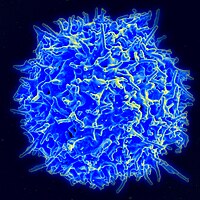
Photo from wikipedia
Mucosal-associated invariant T (MAIT) cells are an evolutionarily conserved T cell subset, which reacts to most bacteria through T cell receptor (TCR)-mediated recognition of metabolites derived from the vitamin B2 biosynthetic pathway.… Click to show full abstract
Mucosal-associated invariant T (MAIT) cells are an evolutionarily conserved T cell subset, which reacts to most bacteria through T cell receptor (TCR)-mediated recognition of metabolites derived from the vitamin B2 biosynthetic pathway. Microbiota-derived signals affect all stages of MAIT cell biology including intra-thymic development, peripheral expansion, and functions in specific organs. In tissues, MAIT cells can integrate multiple signals and display effector functions involved in the defense against infectious pathogens. In addition to anti-bacterial activity, MAIT cells improve wound healing in the skin, suggesting a role in epithelium homeostasis through bi-directional interactions with the local microbiota. In humans, blood MAIT cell frequency is modified during several auto-immune diseases, which are often associated with microbiota dysbiosis, further emphasizing the potential interplay of MAIT cells with the microbiota. Here, we will review how microbes interact with MAIT cells, from initial intra-thymic development to tissue colonization and functions.
Journal Title: Immunity
Year Published: 2020
Link to full text (if available)
Share on Social Media: Sign Up to like & get
recommendations!